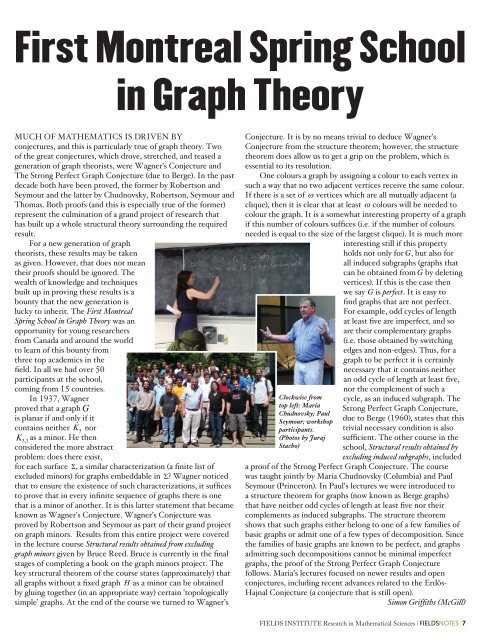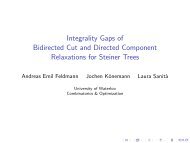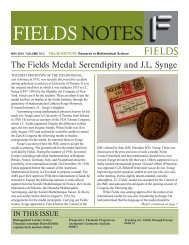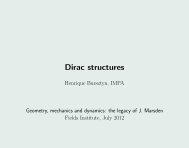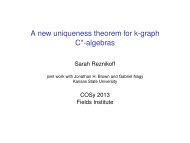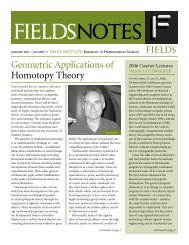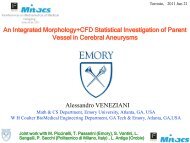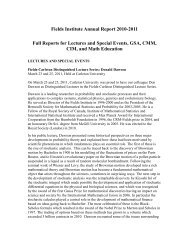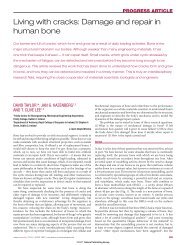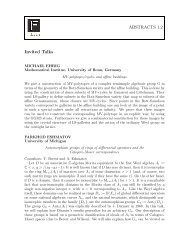SCIENTIFIC ACTIVITIES - Fields Institute - University of Toronto
SCIENTIFIC ACTIVITIES - Fields Institute - University of Toronto
SCIENTIFIC ACTIVITIES - Fields Institute - University of Toronto
You also want an ePaper? Increase the reach of your titles
YUMPU automatically turns print PDFs into web optimized ePapers that Google loves.
First Montreal Spring School<br />
in Graph Theory<br />
MUCH OF MATHEMATICS IS DRIVEN BY<br />
conjectures, and this is particularly true <strong>of</strong> graph theory. Two<br />
<strong>of</strong> the great conjectures, which drove, stretched, and teased a<br />
generation <strong>of</strong> graph theorists, were Wagner’s Conjecture and<br />
The Strong Perfect Graph Conjecture (due to Berge). In the past<br />
decade both have been proved, the former by Robertson and<br />
Seymour and the latter by Chudnovsky, Robertson, Seymour and<br />
Thomas. Both pro<strong>of</strong>s (and this is especially true <strong>of</strong> the former)<br />
represent the culmination <strong>of</strong> a grand project <strong>of</strong> research that<br />
has built up a whole structural theory surrounding the required<br />
result.<br />
For a new generation <strong>of</strong> graph<br />
theorists, these results may be taken<br />
as given. However, that does not mean<br />
their pro<strong>of</strong>s should be ignored. The<br />
wealth <strong>of</strong> knowledge and techniques<br />
built up in proving these results is a<br />
bounty that the new generation is<br />
lucky to inherit. The First Montreal<br />
Spring School in Graph Theory was an<br />
opportunity for young researchers<br />
from Canada and around the world<br />
to learn <strong>of</strong> this bounty from<br />
three top academics in the<br />
field. In all we had over 50<br />
participants at the school,<br />
coming from 15 countries.<br />
In 1937, Wagner<br />
proved that a graph G<br />
is planar if and only if it<br />
contains neither K5 nor<br />
K as a minor. He then<br />
3, 3<br />
considered the more abstract<br />
problem: does there exist,<br />
for each surface Σ, a similar characterization (a finite list <strong>of</strong><br />
excluded minors) for graphs embeddable in Σ? Wagner noticed<br />
that to ensure the existence <strong>of</strong> such characterizations, it suffices<br />
to prove that in every infinite sequence <strong>of</strong> graphs there is one<br />
that is a minor <strong>of</strong> another. It is this latter statement that became<br />
known as Wagner’s Conjecture. Wagner’s Conjecture was<br />
proved by Robertson and Seymour as part <strong>of</strong> their grand project<br />
on graph minors. Results from this entire project were covered<br />
in the lecture course Structural results obtained from excluding<br />
graph minors given by Bruce Reed. Bruce is currently in the final<br />
stages <strong>of</strong> completing a book on the graph minors project. The<br />
key structural theorem <strong>of</strong> the course states (approximately) that<br />
all graphs without a fixed graph H as a minor can be obtained<br />
by gluing together (in an appropriate way) certain ‘topologically<br />
simple’ graphs. At the end <strong>of</strong> the course we turned to Wagner’s<br />
Conjecture. It is by no means trivial to deduce Wagner’s<br />
Conjecture from the structure theorem; however, the structure<br />
theorem does allow us to get a grip on the problem, which is<br />
essential to its resolution.<br />
One colours a graph by assigning a colour to each vertex in<br />
such a way that no two adjacent vertices receive the same colour.<br />
If there is a set <strong>of</strong> ω vertices which are all mutually adjacent (a<br />
clique), then it is clear that at least ω colours will be needed to<br />
colour the graph. It is a somewhat interesting property <strong>of</strong> a graph<br />
if this number <strong>of</strong> colours suffices (i.e. if the number <strong>of</strong> colours<br />
needed is equal to the size <strong>of</strong> the largest clique). It is much more<br />
interesting still if this property<br />
holds not only for G, but also for<br />
all induced subgraphs (graphs that<br />
can be obtained from G by deleting<br />
vertices). If this is the case then<br />
we say G is perfect. It is easy to<br />
find graphs that are not perfect.<br />
For example, odd cycles <strong>of</strong> length<br />
at least five are imperfect, and so<br />
are their complementary graphs<br />
(i.e. those obtained by switching<br />
edges and non-edges). Thus, for a<br />
graph to be perfect it is certainly<br />
necessary that it contains neither<br />
an odd cycle <strong>of</strong> length at least five,<br />
Clockwise from<br />
top left: Maria<br />
Chudnovsky; Paul<br />
Seymour; workshop<br />
participants.<br />
(Photos by Juraj<br />
Stacho)<br />
nor the complement <strong>of</strong> such a<br />
cycle, as an induced subgraph. The<br />
Strong Perfect Graph Conjecture,<br />
due to Berge (1960), states that this<br />
trivial necessary condition is also<br />
sufficient. The other course in the<br />
school, Structural results obtained by<br />
excluding induced subgraphs, included<br />
a pro<strong>of</strong> <strong>of</strong> the Strong Perfect Graph Conjecture. The course<br />
was taught jointly by Maria Chudnovsky (Columbia) and Paul<br />
Seymour (Princeton). In Paul’s lectures we were introduced to<br />
a structure theorem for graphs (now known as Berge graphs)<br />
that have neither odd cycles <strong>of</strong> length at least five nor their<br />
complements as induced subgraphs. The structure theorem<br />
shows that such graphs either belong to one <strong>of</strong> a few families <strong>of</strong><br />
basic graphs or admit one <strong>of</strong> a few types <strong>of</strong> decomposition. Since<br />
the families <strong>of</strong> basic graphs are known to be perfect, and graphs<br />
admitting such decompositions cannot be minimal imperfect<br />
graphs, the pro<strong>of</strong> <strong>of</strong> the Strong Perfect Graph Conjecture<br />
follows. Maria’s lectures focused on newer results and open<br />
conjectures, including recent advances related to the Erdős-<br />
Hajnal Conjecture (a conjecture that is still open).<br />
Simon Griffiths (McGill)<br />
FIELDS INSTITUTE Research in Mathematical Sciences | FIELDSNOTES 7


